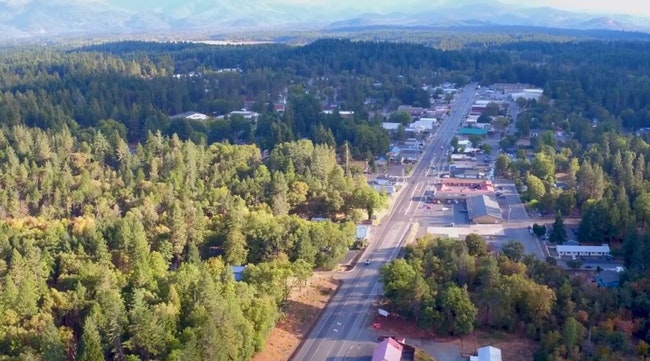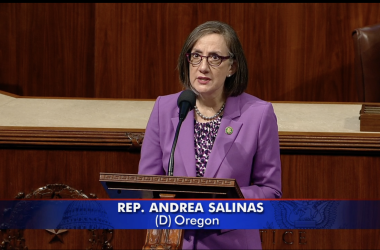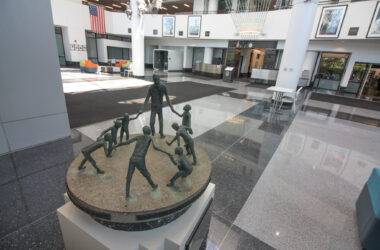
Dozens of households and businesses in Cave Junction got high-speed internet, thanks to money from the CARES Act. (Illinois Valley Data Center)
Oregon will reap at least $100 million to expand broadband services to homes and businesses throughout the state from the new infrastructure bill passed by Congress.
The money has many people’s attention, including lawmakers, internet experts and local governments.
“This is exciting stuff,” said Mallorie Roberts, legislative affairs manager for transportation and community development for the Association of Oregon Counties. “It’s an historic investment. We have to watch how the money flows.”
State Rep. Pam Marsh, an Ashland Democrat who’s pushed legislation to expand broadband access, agreed, calling the money a “game changer.”
“In five years if we use this money strategically, we can have high-quality services for residences and businesses in every corner of the state,” Marsh said.
Business Oregon, the state’s lead economic development agency, is likely to be in charge of spending the money through its broadband office. Right now the agency has no plans for how to use the funds, and it’s not likely to even address that for months.
“This is money down the road,” said Nathan Buehler, spokesman for Business Oregon. “Everyone sees all the hundreds of millions out there. The president hasn’t signed it yet.”
The state’s broadband office was created by Gov. Kate Brown in 2018 through an executive order. Initially, it only had one employee – a manager. In September, he added a program coordinator. Business Oregon awaits more funding to add a few more staff members.
Last year, the agency published both an assessment of the state’s broadband needs and a strategic plan.
The plan says the broadband office is committed to bridging the digital divide, promoting digital literacy, investing in unserved and underserved areas and forging cooperative broadband solutions involving public and private partnerships,.
The assessment determined that 95% of Oregonians have access to the internet, with a basic download speed of at least 25 megabits per second. That’s enough for two people to run five devices, or allow streaming of one high-definition movie.
Nearly 139,000 people have no internet or an extremely slow connection, according to the assessment.
Connectivity speeds vary in Oregon. Cities in the Willamette Valley have good service, according to the state’s broadband map. That’s not the case everywhere, however, with patches of dead zones around the state.
The assessment estimated that it will cost $1.32 billion to get all Oregonians connected to the internet.
The $100 million minimum allocated to Oregon for broadband in the infrastructure bill will provide internet service to nearly 137,000 residents, according to a White House statement.
It indicates that much of the funding is based on population or other formulas, not any specific plan.
The money won’t just appear in Oregon, however.
The state will have to apply for it, just as it is doing now for its share of the $1.9 trillion American Rescue Plan Act that President Joe Biden signed in March. That bill allocated $120 million to Oregon for broadband.
The deadline for applying for that money is Dec. 27. After that, the state’s broadband advisory council will meet, and the broadband office will request proposals, Buehler said. By then the state will know the deadline for submitting projects to the federal government.
State officials expect Oregon to get the money in September. That means the projects won’t start until then – a year and a half after the money was approved by the Congress.
“People see the headlines and think it’s easy,” Buehler said. “There’s a good reason that there’s a process. This is a lot of money. (They) don’t just hand out duffle bags full of cash.”
Though the broadband office doesn’t have a wish list, it has laid some groundwork for the earlier pandemic-related funding by getting approval from the Legislature this year to spend it when it comes.
“We have to get permission from the Legislature to apply for and receive those funds because we have caps on the amount of money we have,” Buehler said. “We have a legislatively adopted budget like all state agencies.”The process for getting the infrastructure money could follow the same long timeline as the rescue plan funds, which means that Oregonians wouldn’t reap the benefits for more than a year.
“You will start to see projects gearing up in the next 12 months,” Marsh said.
Right now she’s working on a bill that spells out strategies for broadband in the state and gives the Broadband Advisory Council more authority.
“We now have a whole lot more money,” Marsh said. “We really want to support the office in having the capacity and direction to spend it.”
She said the money will not only allow Oregon to expand internet services but also will fund digital literacy programs to give people access to the technology and teach them how to use it.
“We’ve come a long way with that in the pandemic, with health care (companies) and schools reaching out to people in a proactive way to make sure they have access to technology,” Marsh said.
Last August, the Legislature and Brown gave Business Oregon $11.6 million from the CARES Act to pay for internet access for residents and businesses in underserved areas.
A small slice – $1.6 million – was spent on 26 projects that created WiFi hotspots and internet access for schoolchildren to enable them to attend online classes.
School districts that won more than $100,000 include the Dallas School District ($121,000), Morrow County School District ($120,000), Multnomah Education Service District ($306,000), Umatilla School District ($121,000) and ($122,000) for the Northwest Regional Education Service District, which serves students in Clatsop, Columbia, Tillamook and Washington counties.
Another $10 million was spent on 28 projects devoted to broadband for online medical consultations, remote work and distance learning in underserved areas. Cities, counties, tribes, cooperatives, school districts and private internet service companies benefited.
In Cave Junction, a local provider, the Illinois Valley Data Center, spent about $124,000 on laying high-speed fiber optic lines to a low-income neighborhood with more than 110 residences, home to dozens of teachers, students and home office workers. People using a shared office space and health care professionals in a medical clinic benefitted as well.
“It checked all the boxes,” said Cameron Camp, owner of the data center.
The clinic can now hold televisits with patients, Camp said, and schoolchildren can study online.
Sally Clements, a Three Rivers School District educator who helped with the project by interviewing parents, said in a video that before the fiber optic lines were laid, video classes were difficult.
“There are so many pockets in our valley that it’s hard to get any internet service,” Clements said.
Now the neighborhood has download speeds of at least 100 megabits per second.
“It has made a huge difference,” Clements said. “The speed is really fast. I feel that I can keep the kids more motivated because I can move from one subject to another quickly and we could bring in field trips for them.”The project helped the Reeds, who have five children. Natasha Reed, the mother, said in the video that their internet service before was limited.
“If somebody needed to get online to do something, we had to tell everyone to shut everything off just so they could get what they needed,” Reed said.
The fiber optics changed that. Now the whole family can be connected, each doing different activities.
The project also changed the life of Aran Eversman, owner of Mellowest, a small marketing and video production company. He does all his business online, he said in an email.
“From the marketing platforms we use to the video content we create, everything gets uploaded, emailed or transferred via the cloud in some way,” Eversman wrote.
But the speeds limited his business. When he heard about the project, he said he rented an office in the neighborhood and signed up for the service.
“Over the course of the last 18 months, we’ve experienced business growth, increased client retention and upload times that were reduced from two hours to a few seconds,” Eversman wrote. “IV Data’s high-speed internet has been transformative in my business and day-to-day life. And given all of the bandwidth demands during the worst of the Covid-19 pandemic, I doubt my small business (would) have survived, plain and simple.”
Another project spent overo $314,000 on providing internet service to more than 150 children in Independence and Monmouth who qualified for free or reduced price lunches and didn’t have internet access at home.
“This enabled everybody in Independence and Monmouth to have equal access to distance learning,” said Shawn Irvine, economic development director for the city of Independence.
Fiber optic lines already exist in the city limits, but not everyone has service.
“It was mostly a matter of dropping service lines from the road to the house and getting them connected up to the system,” Irvine said.
The money was used to pay the monthly service fee, as well. Though that has stopped, all of the low-income families qualify for federal help to pay for broadband service, Irvine said. He does not know how many families have signed up.
“We’ve been advertising it,” Irvine said. “All of those families should have received information about how to apply.”
Besides connecting households, the city created 25 WiFi hubs in public areas and expanded the range of hotspots in the Independence Civic Center, Independence Heritage museum, the city’s library, a popular park and garden.
Each one can handle several hundred users at a time, Irvine said.
The new hotspots are reserved for students. The only way to access them is with one of the 5,000 Chromebooks the school district gave to students. The computers will automatically connect to a hotspot.
The project also had a disaster preparedness element. The hotspot landing pages have information about what to do in a disaster, and the city created a mobile hotspot with a generator and solar panels.
Irvine said the project turned out well.
“I feel like we’ve really laid a strong foundation for future resilience and response to problems like Covid but natural disasters as well,” Irvine said.
In a report on the project, Irvine and a colleague said the project took longer than expected. The city, which operates its own internet service, depended on the school district to get the names of qualified children and the project was stalled by supply chain disruptions. But it was completed in time.
Business Oregon is not sending officials to verify each project, though project managers had to supply receipts.
“We look at the invoices,” Buehler said.
Camp said he hopes Business Oregon ensures the grant money is well spent.
“They need to verify that the people who got the money did what they said they were going to do with it,” Camp said.
His experience with the agency has been good, he said, and he welcomed the slow pace of getting projects off the ground.
“The faster they put a project together the less likely it will have all of the checks and balances,” Camp said.
Oregon Capital Chronicle is part of States Newsroom, a network of news bureaus supported by grants and a coalition of donors as a 501c(3) public charity. Oregon Capital Chronicle maintains editorial independence. Contact Editor Les Zaitz for questions: [email protected]. Follow Oregon Capital Chronicle on Facebook and Twitter.
STORY TIP OR IDEA? Send an email to Salem Reporter’s news team: [email protected].









